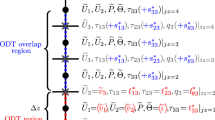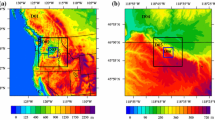Abstract
The applicability of the one-way nesting technique for numerical simulations of the heterogeneous atmospheric boundary layer using the large-eddy simulation (LES) framework of the Weather Research and Forecasting model is investigated. The focus of this study is on LES of offshore convective boundary layers. Simulations were carried out using two subgrid-scale models (linear and non-linear) with two different closures [diagnostic and prognostic subgrid-scale turbulent kinetic energy (TKE) equations]. We found that the non-linear backscatter and anisotropy model with a prognostic subgrid-scale TKE equation is capable of providing similar results when performing one-way nested LES to a stand-alone domain having the same grid resolution but using periodic lateral boundary conditions. A good agreement is obtained in terms of velocity shear and turbulent fluxes, while velocity variances are overestimated. A streamwise fetch of 14 km is needed following each domain transition in order for the solution to reach quasi-stationary results and for the velocity spectra to generate proper energy content at high wavelengths, however, a pile-up of energy is observed at the low-wavelength portion of the spectrum on the first nested domain. The inclusion of a second nest with higher resolution allows the solution to reach effective grid spacing well within the Kolmogorov inertial subrange of turbulence and develop an appropriate energy cascade that eliminates most of the pile-up of energy at low wavelengths. Consequently, the overestimation of velocity variances is substantially reduced and a considerably better agreement with respect to the stand-alone domain results is achieved.













Similar content being viewed by others
References
Brown AR, Derbyshire SH, Mason PJ (1994) Large-eddy simulation of stable atmospheric boundary layers with a revised stochastic subgrid model. Q J R Meteorol Soc 120:1485–1512
Catalano F, Moeng CH (2010) Large-eddy simulation of the daytime boundary layer in an idealized valley using the Weather Research and Forecasting numerical model. Boundary-Layer Meteorol 137:49–75
Charnock H (1955) Wind stress on a water surface. Q J R Meteorol Soc 81:639–640
Deardorff JW (1980) Stratocummulus-capped mixing layers derived from a three-dimensional model. Boundary-Layer Meteorol 18:495–527
Germano M, Piomelli U, Moin P, Cabot WH (1991) A dynamic subgrid-scale eddy viscosity model. Phys Fluids 3:1760–1765
Grossman RL (1982) An analysis of vertical velocity spectra obtained in the BOMEX fair-weather, trade-wind boundary layer. Boundary-Layer Meteorol 23:323–357
Jiménez PA, Dudhia J, González-Rouco JF, Navarro J, Montávez JP, García-Bustamante E (2012) A revised scheme for the WRF surface layer formulation. Mon Weather Rev 140:898–918
Khanna S, Brasseur JG (1998) Three-dimensional buoyancy- and shear-induced local structure of the atmospheric boundary layer. J Atmos Sci 55:710–743
Kirkil G, Mirocha JD, Chow FK, Bou-Zeid E (2012) Implementation and evaluation of dynamic subfilter-scale stress models for large-eddy simulation using WRF. Mon Weather Rev 140:266–284
Knievel JC, Bryan GH, Hacker JP (2007) Explicit numerical diffusion in the WRF model. Mon Weather Rev 135:3808–3824
Kosović B (1997) Subgrid-scale modelling for the large-eddy simulation of high-Reynolds-number boundary layers. J Fluid Mech 336:151–182
Kosović B, Curry JA (2000) A large eddy simulation study of a quasi-steady, stably stratified atmospheric boundary layer. J Atmos Sci 57:1052–1068
Lilly DK (1966) On the application of the eddy viscosity concept in the inertial sub-range of turbulence. NCAR manuscript No. 123. National Center for Atmospheric Research, Boulder
Lilly DK (1967) The representation of small-scale turbulence in numerical experiments. IBM Scientific Comuting Symposium on Environmental Sciences, White Plains, pp 195–210
Lu H, Porté-Agel F (2010) A modulated gradient model for large-eddy simulation: application to a neutral atmospheric boundary layer. Phys Fluids 22:015109
Mason PJ, Thomson DJ (1992) Stochastic backscatter in large-eddy simulations of boundary layers. J Fluid Mech 242:51–78
Mirocha JD, Lundquist JK, Kosović B (2010) Implementation of a nonlinear subfilter turbulence stress model for large-eddy simulation in the Advanced Research WRF model. Mon Weather Rev 138:4212–4228
Mirocha JD, Kirkil G, Bou-Zeid E, Chow FK, Kosović B (2013) Transition and equilibration of neutral atmospheric boundary layer flow in one-way nested large eddy simulations using the Weather Research and Forecasting model. Mon Weather Rev 141:918–940
Moeng CH (1988) A large-eddy-simulation model for the study of planetary boundary-layer turbulence. J Atmos Sci 41:2052–2062
Moeng CH, Sullivan PP (1994) A comparison of shear- and buoyancy driven planetary boundary layer flows. J Atmos Sci 51:999–1022
Moeng CH, Wyngaard JC (1988) Spectral analysis of large-eddy simulations of the convective boundary layer. J Atmos Sci 45:3575–3587
Moeng CH et al (1996) Simulation of a stratocumulus-topped planetary boundary layer: intercomparison among different numerical codes. Bull Am Meteorol Soc 77:261–278
Moeng CH, Dudhia J, Klemp J, Sullivan PP (2007) Examining two-way grid nesting for large eddy simulation of the PBL using the WRF model. Mon Weather Rev 135:2295–2311
Monin AS, Obukhov AM (1954) Basic turbulence mixing laws in the atmospheric surface layer. Tr Inst Teor Geofiz Akad SSSR 24:163–187
Muñoz-Esparza D, Cañadillas B, Neumann T, van Beeck J (2012) Turbulent fluxes, stability and shear in the offshore environment: mesoscale modelling and field observations at FINO1. J Renew Sustain Energy 4(063):136
Pino D, Vilá-Guerau de Arellano J (2008) Effects of shear in the convective boundary layer: analysis of the turbulent kinetic energy budget. Acta Geophys 56:167–193
Pope SB (2000) Turbulent flows. University Press, Cambridge, 771 pp
Porté-Agel F, Meneveau C, Parlange MB (2000) A scale-dependent dynamic model for large-eddy simulation: application to a neutral atmospheric boundary layer. J Fluid Mech 415:261–284
Skamarock WC (2004) Evaluating mesoscale NWP models using kinetic energy spectra. Mon Weather Rev 132:3019–3032
Skamarock W et al (2008) A description of the advanced research WRF version 3. NCAR Tech. Note NCAR/TN-475+STR, 113 pp
Smagorinsky J (1963) General circulation experiments with the primitive equations. I. The basic experiment. Mon Weather Rev 91:99–152
Stull RB (1988) An introduction to boundary layer meteorology. Kluwer Academic Publishers, Dordrecht, 666 pp
Sullivan PP, McWilliams JC, Moeng CH (1994) A subgrid-scale model for large-eddy simulation of planetary boundary-layer flows. Boundary-Layer Meteorol 71:247–276
Sullivan PP, Moeng CH, Stevens B, Lenschow DH, Mayor SD (1998) Structure of the entrainment zone capping the convective atmospheric boundary layer. J Atmos Sci 55:3042–3064
Weckwerth TM, Horst TW, Wilson JW (1999) An observational study of the evolution of horizontal convective rolls. Mon Weather Rev 127:2160–2179
Acknowledgments
DME wants to thank the support from the Marie Curie FP7-ITN-WAUDIT Project # 238576, which partially funded this research. All the numerical simulations were performed using the Supercomputing facilities of the von Karman Institute. The authors are very thankful to Dr. Beatriz Cañadillas for her help with the FINO1 data that was used to initialize the computations. We also thank the Deutsches Windenergie Institut (DEWI) for providing the offshore field measurements from the FINO1 platform. We acknowledge our two anonymous reviewers for their constructive and insightful reviews that improved the quality of the manuscript.
Author information
Authors and Affiliations
Corresponding author
Rights and permissions
About this article
Cite this article
Muñoz-Esparza, D., Kosović, B., García-Sánchez, C. et al. Nesting Turbulence in an Offshore Convective Boundary Layer Using Large-Eddy Simulations. Boundary-Layer Meteorol 151, 453–478 (2014). https://doi.org/10.1007/s10546-014-9911-9
Received:
Accepted:
Published:
Issue Date:
DOI: https://doi.org/10.1007/s10546-014-9911-9




